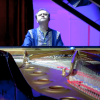Home » Jazz Musicians » Art Tatum
Art Tatum
Art Tatum was born in Toledo, Ohio and despite being blind in one eye and only partially sighted in the other he became arguably the greatest jazz piano player who ever lived.
He came from a musical family and when younger had some formal training at the Toledo School of Music, however he was largely self-taught. His teacher their recognized his talents and tried to steer him towards as a career as a classical concert pianist. Tatum was more interested in the music of Fats Waller, which would be a strong influence on his music. At 18 he was playing interludes at a local radio station and within a short period of time he had his own show. In 1932 he was heard by the singer Adelaide Hall who brought him to New York as her accompanist. One year later he made his first recordings, among which was "Tiger Rag", though a 1932 test pressing of the the same song eventually appeared. This song which features breakneck tempo and rippling left- hand and right-hand cascades and crashing bass notes had every pianist in the country amazed by his astonishing dexterity.
While in New York he established his reputation in "cutting contests" with other top pianists, which he never lost, overwhelming both Fats Waller and James P. Johnson during his first visit to the Big Apple. He spent the next few years playing in Cleveland, Chicago, New York and Los Angeles and even England in 1938. During this time he established himself as a major figure in jazz circles. In the early 1940s Tatum formed an extremely popular trio with bassist Slam Stewart and guitarist Tiny Grimes. He spent much of the next decade touring North America. In 1953 Tatum signed by producer Norman Granz and recorded extensively both as a soloist and in small groups with Benny Carter, Buddy DeFranco, Roy Eldridge, Lionel Hampton, Ben Webster, Harry Sweets Edison and others. His incredible talent allowed him to be extremely productive during this time. Ray Spencer in his biography, noted that Tatum was constantly "refining and honing down after each performance until an ideal version remained needing no further adjustments". This allowed him to achieve a remarkable work rate. For example, his solo sessions for Granz were mostly completed in two days. That is a total of 69 tracks and all but three of them needed only one take. Sadly, on Nov. 5, 1956 his prodigious output was cut short when he died of uremia, however his artistic influence has been strong and long-lasting.
Read moreTags
Out from the Vaults

by Patrick Burnette
The most recent Record Store Day episode is barely in the rear-view, but the boys decide to take on four more vault finds dug up by jazz detective Zev Feldman. Which ones are keepers and which ones get the dreaded label “redundant" and an invite off the island (or, at least, out of the record collection)? Only listening to this podcast will answer that query! Playlist Discussion of Yusef Lateef's album Atlantis Lullaby (Elemental) 3:00 Discussion of Sun ...
Continue ReadingArt Tatum: Jewels in the Treasure Box

by Stefano Merighi
Non vi è dubbio che nel pantheon dei grandi individualisti del jazz, la figura di Art Tatum giochi un ruolo del tutto speciale. Non vedente dalla nascita, giocoforza discriminato, la sua rivincita sociale e artistica è stata epocale, un uno contro tutti memorabile, che lo ha collocato nel più alto dei gradini del talento strumentale. È vero che nulla viene dal nulla, che Tatum è stato debitore per lo meno nei confronti di Fats Waller, ma è indiscutibile ...
Continue ReadingArt Tatum: Jewels In The Treasure Box

by Pierre Giroux
In the annals of jazz history, certain recordings stand out as treasures, not only capturing the essence of a particular era but also the sheer brilliance of the musicians involved. Jewels In the Treasure Box, the 1953 Chicago Blue Note Jazz Club recordings, featuring the virtuosic trio of Art Tatum on piano, Everett Barksdale on guitar and Slam Stewart on bass, is undeniably one such gem. This three-CD set of newly unearthed, unissued live recordings is being released on Resonance ...
Continue ReadingEffervescence: Art Tatum Meets Champagne

by Kristen Lee Sergeant
Join Kristen in a conversation about what makes bubbles so, how no talent is ever undisputed, and how to marvel at the one man show that is the legendary Art Tatum, featuring Champagne by Ployez-Jaquemart and Tatum's rendition of “Night and Day" by Cole Porter. ...
Continue ReadingEffervescence: Art Tatum Meets Champagne

by Kristen Lee Sergeant
This edition of Jazz & Juice comes with a warning: both the bottle featured and the musician spotlighted are explosive, and should be handled with care. Uncork and listen responsibly. Effervescence When something sparkles, literally or figuratively, it bursts with life. In liquid, there is a perpetual motion of bubbles escaping in a dazzling show of speed within a seemingly static glass. When we listen to effervescent music, we experience something that lifts us in delight and velocity ...
Continue ReadingInto the ‘Now’s The Time’ Warp & Much More

by Marc Cohn
Oh, what a show for you! We start with twenty-first century New-Orleans-centric sounds from Charlie Dennard on the B-3, Billy Martin's Wicked Knee, Binker Golding, and a sexy song from Herlin Riley. We celebrate the life of Sonny Rollins with tracks from his Jazz Contrasts sideman gig with Kenny Dorham. And then there are two really top-shelf classics: Brubeck & Rushing (Dave's centennial year) and Art Tatum at the 88s with altoist Benny Carter. Then the professor goes for a ...
Continue ReadingNorman Granz and Verve Records (1944 - 1962)

by Russell Perry
In July 2, 1944, Norman Granz, a jazz fan and small-time LA promoter staged a concert in the Philharmonic Auditorium with $300 of borrowed money. His “Jazz at the Philharmonic" concerts were hugely successful and became tours that ran until 1957. These tours and the record labels they spawned—Clef, Norgran and especially Verve—became home to many of the great players of the 1950s, often mainstream players who had a lot of music left to play, but were not necessarily at ...
Continue ReadingDocumentary: Art Tatum

Source:
JazzWax by Marc Myers
Art Tatum changed pop and rock 'n' roll. As Les Paul tells it, he was originally a pianist with a trio and determined to be exceptional. Until his friend played him a record by Art Tatum. Paul says he stopped playing piano and switched to guitar. Had Paul not heard Tatum and had he gone on to lead a piano trio, we likely wouldn't have had overdubbing, tape delay, phasing effects and multitrack recording not to mention the solid body ...
read more
Art Tatum and Ben Webster

Source:
JazzWax by Marc Myers
For me, jazz is divided between those who recorded with Art Tatum and those who didn't. Tatum remains king of the jazz piano—a briskly shaken cocktail of unrivaled technique, impeccable taste and a staggering ability to make you fall in love whatever song he's playing. Every one of his recordings is a gem, exhibiting daring, speed and lyricism. In solo and trio recordings, you are exposed to raw Tatum in all his centipedic glory. But in group settings, you get ...
read more
Videos: Art Tatum at the Piano

Source:
JazzWax by Marc Myers
Speaking of jazz piano, fans may be unaware that videos of Art Tatum in action exist and that the piano master also appeared in a couple of movies. There's also tape of Tatum's voice, which turns a name on a record label into a warm and charming guy... Here's Tatum at New York's 3 Deuces, at 72 W. 52nd St.... Here's Tatum playing Yesterdays... Here's Tatum in The Fabulous Dorseys. The personnel can be seen in the first ...
read more
Shelly Berg Plays Art Tatum This Week on Riverwalk Jazz

Source:
Don Mopsick
This week on Riverwalk Jazz, actor Vernel Bagneris offers a glimpse of Art Tatum through the words of jazz musicians who knew him, and noted pianist Shelly Berg performs Tatum masterworks with the Jim Cullum Jazz Band. The program is distributed in the US by Public Radio International, on Sirius/XM sattelite radio and can be streamed on-demand from the Riverwalk Jazz website. Squarely grounded in the stride piano style of James P. Johnson and Fats Waller, Art Tatum took solo ...
read more
Who is Art Tatum Dating? By Steve Provizer

Source:
Brilliant Corners, a Boston Jazz Blog
Was the saturation coverage of George Shearing's recent death commensurate with his musical contributions? To my ears, Shearing's music is pleasurable and well-crafted but unexciting. He was capable of playing any style, but the chosen format of his most well-known groups was harmonically consonant and the soloing, while very adept, lacked edge. Shearing's coverage was the equal of that given to Billy Taylor. Taylor was a creative musician, not a musical innovator, but his work as activist/mentor/educator kept his profile ...
read more
Sculptor Cork Marcheschi Creates Art Tatum Memorial

Source:
Michael Ricci
After winning a competition, public sculptor Cork Marcheschi creates the Art Tatum Celebration Column in Toledo, Ohio, in honor of that city's jazz genius Art Tatum, a beautifully-illuminated 30 foot sculpture of a piano keyboard with a twist. The Art Tatum Celebration Column in Toledo, Ohio, the most expensive piece of public art ever installed in that city, was dedicated on September 11, 2009. The column was conceived, designed and built by Cork Marcheschi, a San Francisco public artist and ...
read more
Art Tatum's Historical Recording Garners JJA Jazz Awards Nomination

Source:
All About Jazz
2009 JJA JAZZ AWARDS NOMINATES ART TATUM'S PIANO STARTS HERE FOR BEST HISTORICAL RECORDING / REISSUE
The Jazz Journalists Association has nominated Art Tatum's Piano Starts Here: Live at The Shrine for Best Historical Recording/Reissue of 2009. The Tatum disc is the second recording in a series of discs, using technology developed by Zenph Studios, that represent a milestone in the history of recorded music. The original recording, an incomparable jazz album that highlights the mastery of this singular musician, ...
read more
Memorial to Jazz Pianist Art Tatum Takes Form in Impressive Sculpture

Source:
All About Jazz
The brilliant jazz pianist, Art Tatum (1909-1956) is being honored by his hometown of Toledo, Ohio with an impressive sculpture that will be unveiled in the Fall of 2009. For years the Toledo community has been discussing ways to honor its favorite son. A renowned sculptor and jazz enthusiast from San Francisco, Cork Marcheschi, was selected to create a fitting tribute that will be completed in October of 2009, the date of the 100th anniversary of Art Tatum's birth. It ...
read more
Art Tatum Re-Performance at the Apollo Theater

Source:
All About Jazz
Zenph Studios, a software company specializing in the re-creation of musical recordings using a proprietary blend of computerized and human analysis, announces a revolutionary new show featuring the artistry of legendary jazz pianist Art Tatum. Through Zenph's unique process, one of the jazz legend's most famous albums will be re-performed live onstage using high-resolution “SE" reproducing piano technology supplied by Live Performance, Inc. of Reno, Nevada. Premiering at the world-famous Apollo Theater on June 19, 20, and 22, this dramatic ...
read more



















































































